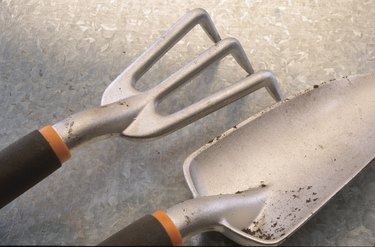Things You'll Need
Shovel or garden trowel
Plastic bucket
Zip-lock plastic bag
Dust mask

A naturally occurring element, arsenic is found in the environment combined with other natural elements including oxygen, sulfur and chlorine or in organic matter. Inorganic arsenic can be found in many kinds of rocks and ores that contain nickel, lead, copper or iron. Arsenic, the 20th most plentiful element in the earth's crust is often found in soil as residue from industrial sites. Both organic and inorganic arsenic compounds are colorless or white powders. Arsenic does not evaporate and has no taste or odor. Without chemical laboratory analysis, it is impossible to tell if arsenic is present in air, water or soil.
Step 1
Evaluate your property for potential arsenic toxicity. Review the historical use of the land. Homes built on the site of previous lumber yards, sawmills or industrial facilities may have been constructed on contaminated soil. Pressure treated wood is impregnated with heavy metals, including arsenic, chromium and copper, to make the wood weather resistant. These heavy metals slowly leech out into soil and ground water. Locations where this material was applied or treated wood was stored may have high arsenic concentrations. Children that climb on playground equipment manufactured from pressure-treated wood as well as pets that like to hide under wooden decks, are at risk for arsenic exposure.
Video of the Day
Step 2
Test the soil. Take several random samples of the garden plot or yard. Dig a hole 8 to 10 inches deep. Move back 1 inch from the edge of the hole and remove a clean slice of soil, 8 to 10 inches deep. Place the soil in a plastic bucket. Do not use a metal pail as metal can contaminate the test results. Continue in the same manner, taking slices of soil in random locations. Place all the sample slices in the same bucket and mix well, removing rocks and roots.
Step 3
Spread the sample media on several layers of newspaper to dry completely. Make sure the soil is dry. Damp soil will not provide accurate test results. When the soil is dried, place 1 pint of the material in a zip-lock plastic bag for submission to a testing laboratory. Request a complete soil analysis, specifically requesting that the lab test for arsenic. Testing is available from county extension offices or the agricultural departments of most universities and colleges. County extension offices also have test kits available for testing the wood on decks or playground equipment. Request a "wood wipe" test kit for arsenic.
Tip
A newly developed hybrid fern, edenfern, is a soil cleaning plant that concentrates arsenic it extracts from the soil and groundwater at levels more than 200 times more than other plants. The edenfern fronds are harvested for disposal and topsoil is preserved. Edenfern ferns are available for purchase from home and garden supply stores or on the internet.
Warning
Wear gloves when handling garden soil as to not contaminate the soil sample.
Video of the Day